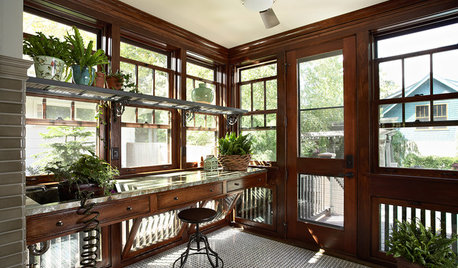Earthbox potting soil
CarolynA
18 years ago
Related Stories

CONTAINER GARDENSContainer Gardening Basics: The Dirt on Soil
Learn the types of potting soil available and the best mixes to help your containers thrive
Full Story
GARDENING GUIDESGrow a Beautiful Garden in Alkaline Soil
Got alkaline soil? Learn how to manage it and the many beautiful plants that will thrive in this ‘sweet’ soil
Full Story
FARM YOUR YARDHow to Get Good Soil for Your Edible Garden
The nutrients in your soil feed the plants that feed you. Here are tips on getting it right — just in time for planting season
Full Story
GARDENING GUIDESHow to Pick a Mulch — and Why Your Soil Wants It
There's more to topdressing than shredded wood. Learn about mulch types, costs and design considerations here
Full Story
GARDENING GUIDESHow to Stop Worrying and Start Loving Clay Soil
Clay has many more benefits than you might imagine
Full Story
GARDENING GUIDES10 Solutions for Soggy Soil
If a too-wet garden is raining on your parade, try these water-loving plants and other ideas for handling all of that H2O
Full Story
SPRING GARDENINGHow to Grow a Rose Garden in Pots
Everything can come up roses, even without a plot of soil in sight. This step-by-step guide to growing roses in containers shows you how
Full Story
CONTAINER GARDENSContainer Garden Basics: How and When to Water Potted Plants
Confused about soil moisture, the best time to water and what watering device to use? This guide can help
Full Story
CONTAINER GARDENSSolve Your Garden Border Dilemmas With Planted Pots
Set your containers free from the patio — placed among plantings in the ground, they fill unsightly gaps, let you experiment and more
Full Story
WINTER GARDENINGWinter Gardening: Ideas for a Dream Potting Room
Check out potting rooms that get indoor gardening right — and learn tips for creating your own
Full StoryMore Discussions








username_5
CarolynAOriginal Author
Related Professionals
Anderson Landscape Contractors · Aloha Landscape Contractors · Blue Springs Landscape Contractors · Round Lake Landscape Contractors · South Lake Tahoe Landscape Contractors · Reisterstown Landscape Contractors · Carson Solar Energy Systems · Aventura Window Contractors · Hilton Head Island Window Contractors · Phelan Window Contractors · Germantown Fence Contractors · Lincolnwood Fence Contractors · Shorewood Fence Contractors · Spring Fence Contractors · Windsor Fence Contractorstapla (mid-Michigan, USDA z5b-6a)
paul3636
tapla (mid-Michigan, USDA z5b-6a)
paul3636
tapla (mid-Michigan, USDA z5b-6a)